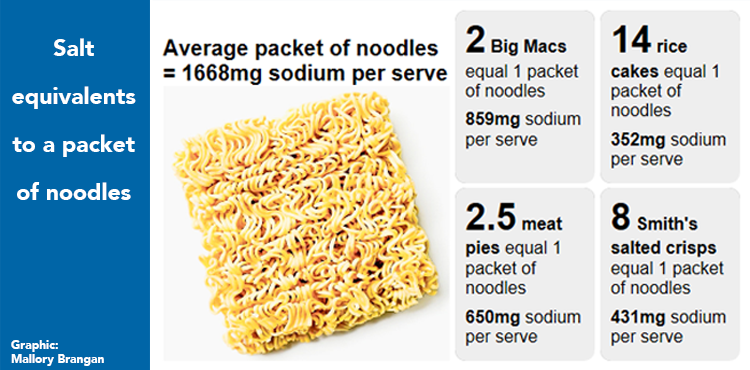
Instant noodles too salty
New research by The George Institute for Global Health reveals the high and unnecessary amount of salt in instant noodles sold in Australia and around the world.
765 noodle products collected from 10 countries between 2012 and 2016 showed huge variations in the amount of salt in instant noodles both within and between countries; with some noodle products containing 30 times more salt than others.
Whilst noodles in China contain the most salt, salt levels in Australia’s noodles are the second highest, with an average packet (86g) containing MORE THAN 80% of the daily recommend maximum intake (5g salt/day)1.
Clare Farrand, Public Health Nutritionist at The George Institute for Global Health, said the findings were especially shocking given that 270 million servings of noodles are consumed worldwide every day2: “Whilst we know that instant noodles contain salt, it’s shocking to see just how much salt is in a single packet. Eating too much salt is estimated to cause about 1.65 million deaths a year globally.
“It puts us at great risk of developing high blood pressure, increasing the risk of stroke, heart disease and heart attacks. Reducing salt intake in Australia by 30% could save thousands of Australian lives a year.”
KEY FINDINGS
- Australia has the second HIGHEST salty instant noodles out of the 10 countries studied (second to China, followed by Indonesia, Fiji, Samoa, UK, Costa Rica, South Africa, India*, New Zealand).
- The saltiest packet of noodles was found in Indonesia which contained (19gsalt /100g). Almost 5 TIMES the Pacific Island target for the salt content of noodles (4g salt/100), and almost 6 times saltier than the Pacific Ocean itself.
- The average packet of instant noodles in Australia contains more than 80% of daily recommended maximum1 and more salt than EIGHT packets of Smith’s ready salted crisps.3
Based on the serving size provided on the pack, the worst offender in Australia was Simplee 2 Minute Noodles Chicken Flavour Instant Noodles which contained 2.67g salt per serving, MORE than HALF a day’s worth of salt. In contrast if you compared products by grams of salt per 100 grams then Maggi.
Mi Goreng Fusian Soy & Mild Spice is the worst offender, even though it ranks as one of the lowest based on labelled salt per serve.
Clare Farrand added: “There is a huge amount of salt in a serving of noodles, but what is more worrying is that in reality people tend to eat the entire packet of noodles, rather than just the recommended serving size, eating even more salt than what is advertised.”
The research further highlights how inconsistent and confusing nutrition labels are in Australia and worldwide with some companies labelling salt per serving, some salt per 100grams as prepared and some salt per 100grams as sold - making it almost impossible to compare.
Clare Farrand said: “Information on pack can be incredibly misleading. There is not a standard serve size, pack sizes differ and the amount of water manufacturers are recommending to add varies considerably.
“Nutrition information should be given a clear and consistent way to enable people to make a healthier choices and manufacturers should reduce salt levels in noodles to below agreed targets.”
To help people make healthier packaged food choices and stay healthy The George Institute for Global Health developed ‘FoodSwitch’ – an innovative mobile health app, which gives instant easy to understand nutrition information for packaged food products, and suggests healthier alternatives.
The app is available in the UK, India, Australia, New Zealand and South Africa can be used to help consumer to make healthier choices.
Recommendations to consumers
- Check the label where possible or use FoodSwitch to choose the lower salt options.
- Limit intake to an occasional meal or side dish.
- Ditch the flavour sachet which contains most of the salt and add your own herbs and spices.
- Or use only a portion of the flavour sachet to reduce your salt intake.
- Drain your noodles before eating, to reduce salt.
- Add some vegetables like spinach which will cook with the steam in the noodles.

